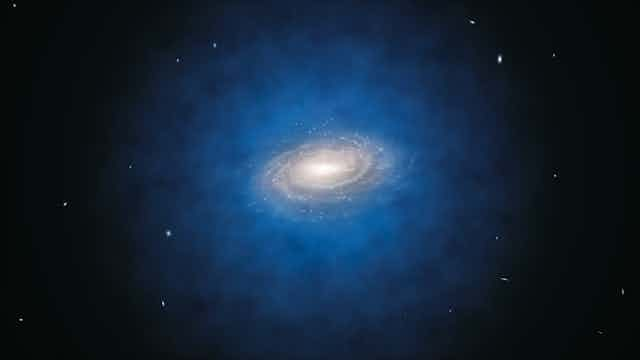Astronomers have been searching for a mysterious substance called “dark matter” since the 1930s. Most scientists still believe it exists, despite many fruitless decades. Now we propose a new theory of general relativity that may ultimately get rid of the need for dark matter, and perhaps get physicists to think in terms of things we know exist.
One reason why physicists have been trying to find dark matter is because of anomalies in the “galaxy rotation curve” data. Matter, such as gas and stars, tends to rotate around the centre of individual galaxies. The variation of this rotation speed if plotted against distance from the centre of the galaxy gives what is known as that galaxy’s rotation curve.
Matter that orbits quite far away from the centre of the galaxy is expected to have a lower rotational speed than matter orbiting closer to the centre. This expectation comes from either those laws based on Newton’s theory or the predictions of Einstein’s theory of general relativity.
But observations consistently show a “flattening” of the rotation curves - in which speeds remain essentially constant beyond a certain distance from the galactic centre. Rather than challenge the theories of Newton and Einstein, it has been accepted that each galaxy must be surrounded by a vast halo consisting of dark matter (termed so because it cannot be directly observed).

We don’t know what dark matter is made of. Even with little knowledge about this mysterious matter, for Einstein’s theory to work, we need to assume that more than half the mass of each galaxy is made of dark matter.
Modifying Newton’s law
An earlier theory called MOND (Modified Newtonian Dynamics) was introduced by Mordehai Milgrom in 1983. This tried to explain the anomaly by a modifying Newton’s second law, according to which gravitational force on orbiting matter can be equated to a product of its mass and acceleration.
At large distances from the galactic centre, this attractive gravitational force becomes very small - as does the expected acceleration. The modification within MOND was made to explain the motion of these distant objects with very small accelerations.
Application of the MOND law has indeed had great success in fitting astronomical observations – without the need to assume the existence of dark matter. Also, MOND’s predictions can fit observed data far more accurately than predictions incorporating dark matter distributions.
But the theory isn’t entirely satisfactory. It was designed specifically to fit the anomalous observational data. Since MOND is not really based on any physical principle, it has been a main goal of recent theoretical physicists to reproduce MOND’s effect through an update of Einstein’s theory of general relativity.
A new theory of general relativity
In our work, appearing in the July edition of the journal of Physical Review D (a preprint of which is available on arxiv), we have developed a new theory of general relativity that may change our understanding of galaxies and the universe. Our proposed theory does not need dark matter to exist to explain galaxy rotation curves.
We have found a simple way to link relativistic gravitational theory - one proposed by Einstein - with some characteristics from MOND. Because these characteristics have already been tested against astronomical data, our new theory has already been thoroughly tested to fit observations.
Other generalisations of Einstein’s theory have been proposed previously. We believe that our extension is more satisfactory in a number of ways.
First, we have been able to prove Einstein’s field equations from a simple and fundamental physical principle: that the presence of matter can both curve and expand space-time. Second, the successes of Einstein’s theory in predicting new effects (such as the details of Mercury’s orbit) can be preserved at shorter, non-galactic scales. Third, explanation of anomalies such as the galaxy rotation curves reduces merely to a simple geometrical consideration. It is precisely because of these simplicities that we believe our theory to be a compelling alternative to rival theories (such as the more complex tensor-vector-scalar gravity theory introduced by Jacob Bekenstein in 2004).
Physicists remain in lively dispute concerning whether dark matter or modified gravity explains what is observed. Particularly controversial is the so-called Bullet Cluster, which involves two clusters of galaxies that are colliding. On one hand, this context arguably provides the strongest evidence for the existence of dark matter. On the other hand, it has been argued that unseen luminous matter can most accurately account for observations.
Our theory, while making progress, now poses many more questions about the origin and evolution of galaxies and the universe. But hopefully those questions won’t be about some mysterious matter that no one has ever seen.

